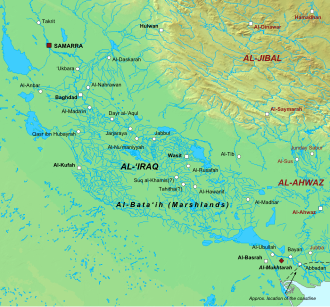Top Qs
Timeline
Chat
Perspective
Zutt Rebellion
From Wikipedia, the free encyclopedia
Remove ads
The Zutt Rebellion was a rebellion by the Zutts, originally inhabitants of the lower Indus Valley (roughly Pakistan),[1][2][3] between 810 and 835 in Iraq during the reign of al-Ma'mun and continued to the era of al-Mu'tasim.
Remove ads
Background
The Rebellion began from the Zutt tribe of Jats, who had migrated into Mesopotamia several centuries ago. They supplied mercenary soldiers for the Ummayyad and Abbasid Caliphate. These soldiers would settle in nowadays Iraq and marry amongst local Arab women. Thus forming the Az-Zutt tribe also known as Banu Zutt.
Rebellion
During circa. 810, Yusuf ibn Zutt began a rebellion against the Abbasid Caliphate which created semi-independent state in the Marshlands of Southern Iraq (Mesopotamian Marshes). Isa ibn Yazid al-Juludi would be sent by caliph Al Ma'mun to crush the rebellion, but would fail to do so. Isa ibn Yazid al-Juludi and Ahmad bin Qutayba would be sent by caliph Al Ma'mun to crush the rebellion, but would fail to do so.[4]
Under the tribal leader, Muhammad Ibn Uthman, rebellion continued when Kufa, Basra, Wasit, Al-Jazira and surrounding places of Baghdad came under his control. This caused a major disruption of resources and food to Baghdad, putting the Abbasids in danger.
Remove ads
Naval raids
Mu'tasim's army employed similarly meticulous tactics to suppress a Zutt rebellion in southern Iraq. However, the new Turkish troops were not involved, as their strategies were ill-suited for the marshes and densely cultivated palm groves. Instead, other forces blocked off hundreds of reedy canals used by the Zutt for raids in small boats, and then methodically advanced into rebel-held territory.[5][6]
Zutt colonization of Khuzestan
The Zutt colonization of Khuzestan refers to the migration and settlement of the Zutt people Muslim communities originally from the Indus Valley region of modern day Pakistan in the marshlands of southwestern Iran during the late Sasanian and early Islamic periods. They established agricultural communities and irrigation infrastructure in Khuzestan. After the suppression of the Zutt rebellion in southern Iraq, many were relocated to Bahrain, where they continued similar activities.[7][8][9][10]
Remove ads
Capture of Basra
The Capture of Basra was a significant event in the Zutt Rebellion. After a series of successful military engagements and leveraging their control over the region's vital waterways and marshlands, the Zutts launched a assault on the city of Basra. Their guerrilla tactics and their strategic advantage in navigating the waterways allowed them to isolate the city and launch surprise raids. The Abbasid Caliphate forces, struggling against the challenging terrain and the Zutt tactics, failed to mount an effective defense.
Remove ads
Capture of Wasit
The Capture of Wasit was an important moment in the Zutt Rebellion. The Zutts, using their dominance over the marshlands and waterways between Wasit and Basra, launched a coordinated attack on Wasit. Their intimate knowledge of the terrain and reliance on guerrilla tactics enabled them to overwhelm Abbasid defenses and seize control of the city.
The Abbasid forces, commanded by Al-Mu'tasim, suffered heavy casualties as they struggled to counter the Zutt's ambushes in the marshes. The fall of Wasit allowed the Zutts to establish temporary rule over the city and destabilized Abbasid authority in the region.[11][12][13]
Remove ads
End of Rebellion
After the passing of al-Ma'mun, al-Mu'tasim becomes Caliph of the Abbasids. With a reformed military, he took charge of the dire situation of the rebellion, sending Ujayf ibn Anbasa to successfully crush the rebellion in 835. He then dispersed the Zutt population to different parts of the Caliphate to prevent another rebellion. Muhammad Ibn Uthman still retained the position of tribal leader after rebellion, however with a weaker force.
Remove ads
External sources
- Houtsma, M. Th. (1993). E. J. Brill's first encyclopaedia of Islam, 1913–1936, Volume 4. Brill Page 901 & 1030.
- Kennedy, H. (2004). The Prophet and the Age of the Caliphates: The Islamic Near East from the 6th to the 11th Century (2nd Edition). Routledge.
- Lewis, B. (1991). The Political Language of Islam. University of Chicago Press.
- Marozzi, J. (2004). The Way of Herodotus: Travels with the Man who Invented History. Da Capo Press.
- The History of Al-Tabari Vol. 33, Page 7
- Outlines of Islamic History From the Rise of Islam to the Fall of Baghdād By Mafizullah Kabir. Page 14, Page 218
- A Short History of Iraq(2014) By Thabit Abdullah
- Warfare in the Dark Ages By Kelly DeVries
- The [European] Other in Medieval Arabic Literature and Culture Ninth-Twelfth Century AD(2012) By Nizar F. Hermes
- Arab-Byzantine Relations in Early Islamic Times(2004) Page 172
- Al-Tabari's "History of the Prophets and Kings"
- Al-Masudi's "The Meadows of Gold and Mines of Gems"
- Ibn Khaldun's "The Muqaddimah
Remove ads
References
Wikiwand - on
Seamless Wikipedia browsing. On steroids.
Remove ads

